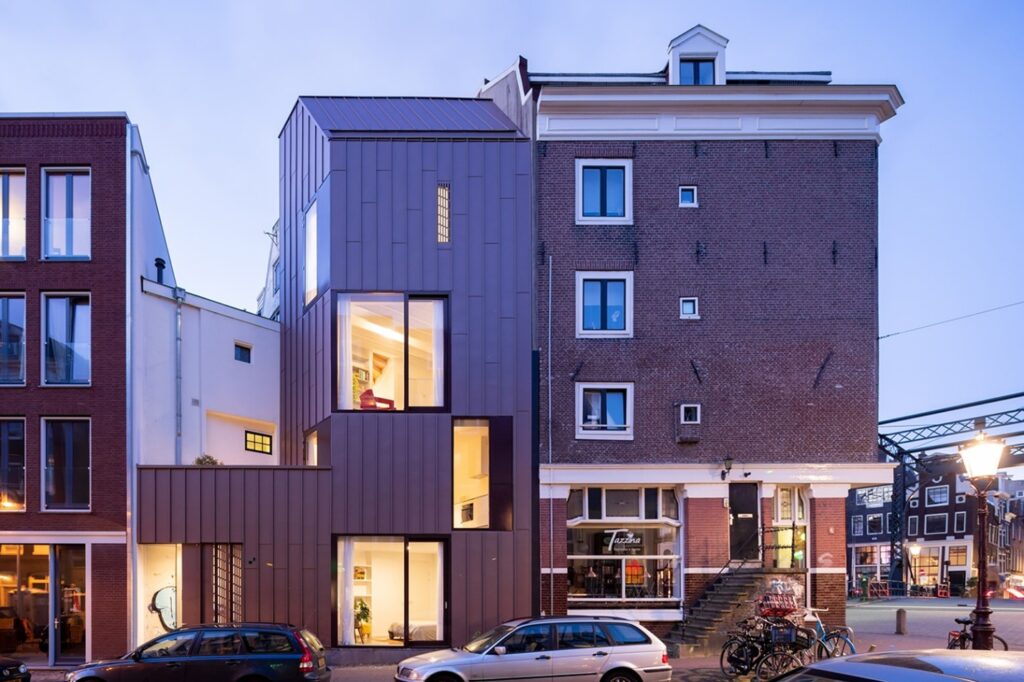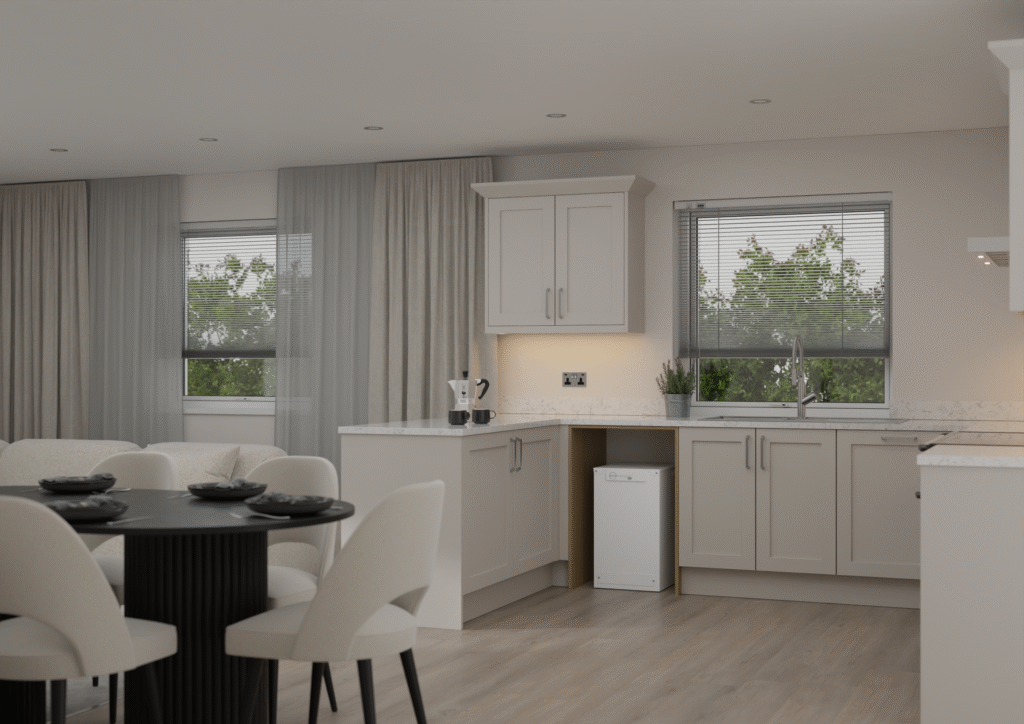Climate change and urbanisation are dual challenges making architects and home developers rethink how modern homes ought to be designed.
Buildings are a major carbon culprit – accounting for about 39% of global energy-related carbon emissions (28% from operations like heating/cooling, and 11% from construction). In the UK, heating alone is the single biggest source of household emissions, roughly 37% of national CO₂ output. To meet the ambitious net zero target by 2050, new and existing homes must drastically cut their carbon footprint.
At the same time, cities are growing: the UN projects 68% of the world’s population will live in urban areas by 2050. This means more people competing for limited land, thereby increasing demand for space-efficient homes that use land and space maximally.
The challenge for architects is clear; designing homes that are
low-carbon by default and space-efficient by design – without sacrificing liveability & aesthetics.
Modern architecture has already transformed. There is a shift towards sustainability and designing homes that minimise energy consumption and reduce environmental impact. Architects are exploring inventive layouts and ‘micro-living’ concepts so that even small sized homes feel comfortable as well as functional. When ‘well designed’, these micro-apartments allow residents to live large with less, proving that quality of life can be well achieved within limited sq. footage area.
But balancing low-carbon performance with compact, contemporary living demands a holistic approach, and heating and hot-water design is often the critical lever.
Low-carbon home design is now imperative
The government will publish the Future Homes Standard (FHS) this autumn before it comes into force from 2026-27. Under FHS, the new Home Energy Model (HEM) will replace SAP for showing compliance and achieving Energy Performance Certification (EPCs), setting homes up to be ‘zero-carbon ready’ as the grid decarbonises.
Currently, the RIBA 2030 Climate Challenge asks housing projects to target ≤35 kWh/m²/yr operational energy by 2030, effectively making energy-efficient design the default benchmark for architectural quality. The Net Zero Carbon Buildings Standard and CIBSE guidance are focusing on a fabric-first, services-right approach that prioritises hot water efficiency and measured outcomes. Achieving such massive reductions means adopting sustainable design strategies in residential architecture:
1) High-performance insulation & airtightness: A well-insulated, airtight building will prevent energy waste. For instance, up to 25% of a home’s heat can escape through the roof, so proper loft insulation improves efficiency. By using advanced insulation in roofs, walls and floors, architects ensure homes stay warm in winter and cool in summer with minimal heating/cooling input.
2) On-site renewable energy: Integrating renewable energy generation into homes further cuts net carbon output, as stated in Net Zero Carbon Buildings Standard. Solar panels on rooftops can deliver clean electricity, and home batteries can harness the surplus solar energy to use during peak times. In sunnier climates, passive solar design and solar water heaters cut energy needs. So well-positioned solar PV can significantly offset a home’s grid consumption, especially as panels become cheaper and more efficient.
3) Low carbon materials and construction: Beyond operational energy, architects are also required to consider cutting embodied carbon, i.e. the CO2 emitted in producing and transporting building materials and during construction. Using sustainable materials can reduce the home’s embodied emissions. Modular construction and retrofitting existing structures (instead of new builds) also help by avoiding waste.
4) The biggest difference maker: energy-efficient heating & hot water
UK homes account for 25% of the UK’s total energy consumption, with about 80% of that used for heating and hot water.
Traditional gas boilers are carbon-intensive, so sustainable homes favour electric heat pumps, solar PV, or connection to low-carbon district heating grids. Heat pumps (air- and ground-source) are seen as the key technology to replace gas boilers, as they transfer ambient heat instead of burning gas, dramatically cutting emissions.
These strategies show that net-zero, energy-efficient homes are well within reach using today’s technology. Gary Clark, Managing Director of HKS London, recently told the Architects’ Journal “We do have all the design strategies and technology to create net-zero homes now that are not only affordable but more healthy and comfortable and would lift many families out of fuel poverty, if we prioritise them in every project.” Another design guide, e-architect, mentions that energy-efficient architecture directly cuts living costs for occupants and even boosts property value, as eco-conscious buyers increasingly seek out highly energy efficient homes. In short, designing for low carbon is a win-win for people and the planet.
Space-efficient homes: “doing more with less”
Alongside the climate crisis is a housing space crisis, especially in dense cities where land is scarce and expensive. The future of housing lies in right-sizing homes: providing comfortable living in a smaller footprint. For architects and designers this means, creative use of every square meter. In many cities, planners and architects are embracing higher density and micro-unit housing as solutions. The so-called “Tiny House Movement” advocates living in small spaces, not just as a lifestyle trend but to address urban housing shortages and sustainability concerns. City authorities are even reforming zoning to allow accessory dwelling units (ADUs) and compact flats, recognising that an excess of large, half-empty houses is neither efficient nor equitable.
However, designing a small home while meeting modern heating & emissions standards requires space planning and innovation in technology.
The next piece of the puzzle is ensuring that these green homes can also address the spatial constraints of modern living.
 Downsizing in favour of functionality and convenience. Towerhouse by Bureau LADA. Amsterdam, Netherlands | Source: architizer
Downsizing in favour of functionality and convenience. Towerhouse by Bureau LADA. Amsterdam, Netherlands | Source: architizer
Why traditional hot water cylinders don’t work while designing modern homes?
As heating moves to cleaner sources like heat pumps, solar panels, and heat networks, homes need hot water storage again. Unlike combi boilers that heat water instantly, these low carbon systems rely on additional thermal storage. But traditional hot water cylinders cause serious challenges for modern home design such as:
Taking up too much space in modern home designs
Hot water cylinders are bulky, often taking up an entire airing cupboard space or a floor to ceiling kitchen unit. In small urban flats, this means losing valuable storage space or compromising flexible layouts. The UK Government’s nationally described space standards even require developers to set aside 0.5 m² in every home just for a cylinder. Cylinders need their own cupboard or utility space, which disrupts open-plan layouts and adds visual clutter. Several home transformation case studies have shown that removing a tank can free up considerable space in compact homes. This goes against the principle of the clean, flexible interiors that contemporary architecture aims for.
Hot water cylinders waste energy & leak heat in homes
Hot water cylinders lose heat constantly, even when no one is using hot water. This “standby loss” means water must be reheated over and over, wasting energy and increasing bills. The University of Exeter found that heat loss from hot water pipes is also a major component of domestic energy use, ranging from as little as 2% to as much as 55% of total hot water energy. These pipe losses also waste water, with up to 2.9-5L lost per shower as residents wait for hot water to arrive at the tap. Also, this means that in busy households, hot water can run out during peak demand, leaving families without hot water when they need it most. And CIBSE warns that traditional cylinders can also worsen overheating in properties, reducing comfort and wasting energy. The UK government’s Approved Document Part O requires design measures to limit overheating, which includes reducing unnecessary internal gains such as standing losses from hot water storage and pipework.
Point of use water heating with high insulation levels can address this problem.
Challenges with Legionella maintenance, limescale and energy efficiency
Large amounts of standing hot water create the conditions for Legionella bacteria to thrive. To prevent this, residents are required to regularly heat water to at least 60C and run energy-intensive anti-Legionella cleaning cycles, adding both cost and maintenance overhead. Cylinders in hard water areas suffer from limescale build-up on their heating elements. Just 1mm of scale can increase energy consumption by 7–10%, gradually cutting the system efficiency every year. While RIBA 2030 Climate Challenge’s target of achieving ≤35 kWh/m²/year operational energy by 2030 for domestic buildings doesn’t single out hot water storage, it makes clear that the largest operational loads, heating and hot water, must be dramatically cut through efficient services and low-carbon system choices.
For architects designing compact or modular homes, the takeaway is clear: traditional cylinders are not exactly fit for purpose. They would have to deliver domestic hot water without a bulky cylinder to free up space, be designed without immersed elements, cut standing losses and costly legionella cycles and annual maintenance, and maintain the modern aesthetics homeowner clients expect from contemporary homes.
How compact Thermino can address the domestic hot water challenge for modern architecture
Sunamp’s phase change material Thermino heat batteries store heat, instead of large volumes of water. Mains pressure water passes through a separate heat exchange loop, delivering on-demand hot water to tap. This means there is no big tank of standing hot water in the house, and none of the design compromises needed.
How does that help with modern architecture?
Getting space back
Thermino is up to 4x smaller than an equivalent hot water cylinder. This can mean reclaiming an entire cupboard or storage zone – a valuable 0.5m² that the UK’s nationally described space standards already assume to be lost to a hot water cylinder. In urban apartments, modular housing or retrofits, this regained footprint is useful for storage, or even flexible workspace.
Achieving compliance
Because Thermino contains <15L water in the system, it avoids the Legionella risks of stored hot water and does not have the regulatory constraints that a large unvented cylinder poses. All it needs is periodic maintenance of external components.
Higher efficiency over time
Unlike conventional immersion elements that are immersed in water, Thermino’s heating is delivered through the coil wall into the PCM. This eliminates the risk of limescale build-up, which can raise energy consumption by 7-10% with just 1 mm of scale, as mentioned before. Architects and homeowners benefit from predictable long-term efficiency and reduced maintenance callouts.
Low standing losses, reduced overheating
Because heat is stored in PCM rather than bulk hot water and because every heat battery is lined with high-performance vacuum insulation panels, Thermino has very low standing losses, up to 4x lower than an old hot water cylinder. This helps reduce unwanted internal heat gains, important for meeting Approved Document Part O requirements in lightweight flats and high-rise schemes where overheating risk is already a concern.
Blending with the modern aesthetics of contemporary new builds:
Thermino’s compact, modular shape means they can be fitted under stairs, under the kitchen sink or in the bottom shelf of a tiny cupboard. This enables clean lines, open plan living, and flexible interiors that define contemporary housing design.
How does Thermino integrate with modern heating?
It is heat source agnostic: Thermino can be charged from heat pumps, communal gas or electric boilers, direct electric, PV diverters, or heat network. This flexibility can allow home developers to retrofit Thermino with existing heating system today and switch to heat pump or heat network in future without disturbing interiors or decanting residents.
PV-ready load shifting: In homes or low-rise blocks with rooftop solar PV, Thermino can store surplus generation during the day and deliver hot water on demand in the evening. This not only supports grid balancing but also improves SAP/Home Energy Model outcomes for architects aiming to achieve higher EPC ratings.
Thermino is already working on modern & retrofit projects across the UK
Whetstone Green Apartments, London – Award-winning net-zero apartments use rooftop solar PV with Thermino heat batteries to provide reliable hot water while keeping the overall design compact. This project is estimated to save ~7.65 tCO₂e in the first year and ~270 tCO₂e over 25 years versus a gas combi baseline, showing how compact storage supports both carbon and space goals in premium urban housing.
LAR Housing Trust, Edinburgh (historic church conversion + newbuild): An old heritage conversion and adjacent newbuilds fitted Kensa Shoebox heat pumps & Thermino heat batteries to deliver modern heating and hot water in tight floor plans, preserving historic charm while achieving clean interiors and usable storage.
Gentoo Group, northern England (Core 364 project): Seven resident tower blocks replaced gas combis with ground source heat pumps & Thermino heat batteries. The compact in-flat storage made the switch feasible without decanting residents, cutting carbon and improving resident comfort in homes that simply couldn’t accommodate cylinders.
A call to architects
As homes become smaller, modern and net zero ready, designing around bulky hot water cylinders will become increasingly difficult. They take up valuable space, interfere with clean layouts, and the older tanks make compliance harder to achieve.
Thermino replaces the hot water tank with a compact, low-carbon solution, freeing space for design.
Whether you are working on apartments, modular schemes, or sustainable housing, Thermino helps you deliver resident comfort without compromise of space or efficiency.
Speak to us about how Thermino can integrate seamlessly into your next project.
Need help evaluating project fit? Click here to get in touch with our technical team to discuss how Thermino can work for your contemporary home designs.
Related articles for specifiers
Future Homes Standard 2025: How low carbon technologies will transform the built environment

Sustainable architecture – how Sunamp heat batteries contribute to low-carbon green buildings

Creating net zero homes: A specifier’s guide to building standards in Scotland
Decarbonising heat networks in social housing? How compact thermal storage plays a crucial role




